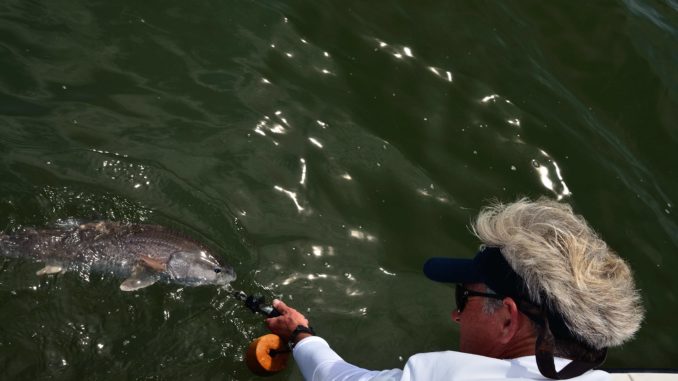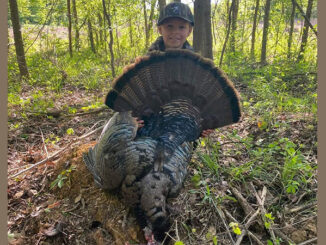
The emergence of crabs puts Grand Strand spring redfish on the prowl. Here’s how to put a claw on them.
It may not match winter in northern climates, but South Carolina does have a season that’s colder than the rest, and when it arrives, redfish gaggle up by the hundreds into tight groups in headwater creeks in marshes, providing anglers with easy-to-find targets. But as soon as Mother Nature turns up the heat at the approach of spring, the fish appear to scatter and vanish into thin air. Fishermen who ply the waters at either end of the Grand Strand who know where to look and how to wiggle their worms can score big during the spring thaw.
Redfish are unique in that adults live apart from their juvenile relatives. The juveniles never leave estuaries for several years, and they overwinter deep in the marsh to get away from predators like porpoises. But when spring weather arrives, food returns, the porpoises have something else to eat, and reds break out of their schools to forage.
According to Jordan Pate of Carolina Guide Service, the inconsistent weather of early spring requires a different plan of attack in the micro-marshes of Pawley’s Island and the waters of North Inlet and Winyah Bay near Georgetown.
“It’s a tricky time of year for finding reds. The reds start to break apart when the threat eases and more food is available around the marsh,” said Pate who believes rising water temperatures and the return of blue crabs trips reds’ triggers. “Blue crabs become available again in the spring when water temperatures rise.”
Blue crabs move into the ocean or inshore areas with higher salinity levels for the winter, burying themselves in the mud and sand. Was the water warms, they, prepare to molt and then spawn.
Pate believes reds are so keyed in on the crabs, when their scent begins to roll through the marsh, they think food, not safety first.
“A redfish’s main spring diet is crabs, and (spring) is when we see the first molt of the year. Redfish love a soft crab,” Pate said.
Blue crabs molt when the water temperatures breaks the 60-degree mark, usually from late March through April. However, crabs aren’t the only thing anglers will find in the bellies of spring redfish.
Greg Holmes of Fish Skinny Charters, who fishes the Little River area, said even though reds will gobble up every crab they find, they’ll supplement their diet with mud minnows and incoming menhaden.
“Mud minnows dig out of the mud, and the first wave of menhaden shows up this time of year, too,” Holmes said. “Food is more abundant, (and) that is just what they need to refuel after the winter.”
Because reds scatter to hunt for food, many anglers have a hard time pinning down a dependable pattern after the break-up.
Holmes starts fishing in areas where reds spent the winter and works his way out to attractive areas.
“There will still be some fish in the winter holding areas, but many fish spread out near deeper water and will position on nearby oyster mounds, creek mouths, and ambush points,” Holmes said.
Places where tributary creeks converge are prime staging areas when fish begin to move. Pate said staying on the move and beating the bank will be profitable for most anglers.
“I like to cover a lot of ground throwing artificial lures. I concentrate on grassy banks, creek mouths and small points in Winyah Bay,” Pate said. “The reds are scattered in small groups, fending for themselves, and you have to cover a lot of ground.”
Pate likes lures that can be retrieved with a constant action, including Egret’s Mambo Mullet, spinnerbaits or a jighead and white Fluke.
Holmes said the size of the lures he uses can be important in the spring. He likes to downsize his lure to match the hatch.
“The fish are focused on smaller baits because that is what is in there. I like to downsize my tackle to smaller-sized baits,” said Holmes, who will use 3-inch Gulp swimming mullet on light jigheads or other small baits that imitate small menhaden or mud minows.
While reds will scatter around the region, they will still be in small groups. Pate and Holmes have similar strategies that employ after catching a fish or two from an area. They will stake out and cast outfits rigged with small chunks of fresh blue crab on a jighead or Carolina rig.
“When you get on some fish, fresh blue crab is as good as anything you can get,” Holmes said.
For anglers ready to make good of a warm, spring day, both the northern end of the Grand Strand around Little River Inlet and the southern end of the Grand Strand at Winyah Bay offer prime spring redfish grounds with plentiful opportunities available to stretch a line.
DESTINATION INFORMATION
HOW TO GET THERE — South Carolina’s Grand Strand is a 60-mile section of beach from Little River near the North Carolina border to Georgetown, S.C. Small marshes are behind Pawley’s Island and Litchfield Beach, and a larger one is at Murrells Inlet, but the majority of redfish habitat is around Winyah Bay and Little River. US 17 offers the best access to the entire area; two public boat ramps under the US 17 bridge at Little River offer access to that area. Three ramps in the Georgetown area are: South Island Ferry, East Bay Park and the Campbell complex north of the US 17 bridge across the Sampit River.
WHEN TO GO — Redfish can be caught year-round along the Grand Strand, but the spring pattern emerges in March when the water temperature hits 60 degrees, because that marks the point when blue crabs emerge from hibernation.
BEST TECHNIQUES — With patrolling marsh edges and oyster banks along creeks for crabs and other baitfish, cover plenty of water with artificial baits such as spinnerbaits, gold Johnson spoons, Gulp Swimming mullet, D.O.A. Jerk and Airhead, Egreg Mambo Mullet and others. When fish are located, stake out and use small pieces of blue crab on a jighead or Carolina rig. Medium-action tackle is preferred, with rules spooled with 20-pound braid with an 18- to 24-inch section of 20-pound fluorocarbon leader.
FISHING INFO/GUIDES — Greg Holmes, Fish Skinny Charters, 843-241-0594, www.fishskinnycharters.com; Jordan Pate, Carolina Guide Service, 843-608-8307, www.carolinaguideservice.com;
ACCOMMODATIONS — Hampton Inn-Georgetown Marina, 843-545-5000; Hampton Inn-North Myrtle Beach/Harbourgate, 843-249-1997; Myrtle Beach Area Convention and Visitors Bureau, www.mbchamber.com; S.C. Association of Visitors Bureaus, www.discoversouthcarolina.com.
MAPS — Navionics, 800-848-5896, www.navionics.com; The Good Spots, 800-411-0184, www.thegoodspots.com; Delorme’s S.C. Atlas & Gazetteer, 207-846-7000, www.delorme.com.







Be the first to comment